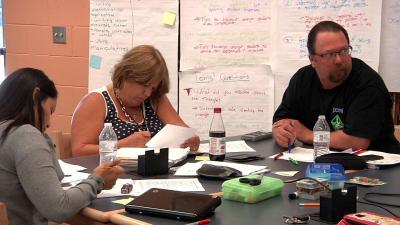NMSU mathematics outreach program trains teachers to think beyond the equation

"It is important to realize that mathematics is not just a series of meaningless procedures that students need to memorize to pass an exam," said Susana Salamanca-Riba, associate professor of mathematics in the College of Arts and Sciences and principal investigator of the Build Leadership in Teachers (BLT) program with Park City Mathematics Institute (PCMI). "If one is able to understand why a problem about speeding trains, a problem about phone plans or a problem about machine efficiency represents problems that have similar mathematical formulations, then one is better suited to recognize and tackle other problems in our own lives that have similar principles."
The Math Science Partnership between NMSU and PCMI began as a three-year grant back in 2006 funded through the National Science Foundation. It started with Japanese lesson study for middle and high school teachers. Salamanca-Riba says lesson study helps teachers think about how their students learn and helps them to define a learning goal and design a lesson that will help students learn that goal.
"Japanese lesson study fosters an understanding of the learning process," Salamanca-Riba said. "People do not grasp abstract concepts just because someone tells them. One needs to go through a process of assimilation of the ideas. Students need to understand why something works the way it does, not just how it works."
NMSU's partnership with PCMI has supported an average of 20 participants among math teachers in middle and high schools each year since the partnership began in 2006 and another 10 in the leadership group. The latest group of teachers entered the year-long leadership program last August to learn the concepts, work with other teachers and develop math units for their classes. Throughout the year, the teachers worked both with Salamanca-Riba and on their own to explore different ways certain math problems could be solved.
"We'd get together every Thursday for two hours and we'd work on math problems, on the content," said Soledad Gonzalez, one of three teacher leaders in the program and a math teacher at Mesa Middle School. "That same semester we had to come back and create a unit for our students and analyze the unit, analyze the results to see if there was student improvement and we taught it in accordance with what we had learned."
Salamanca-Riba explained when students are asked to explore the problem situation rather than being told what the equation would be, students are led to the discovery. If they arrive at the concept themselves they are more likely to understand it and retain it. PCMI philosophy is about making connections and allowing students to solve problems in their own ways. With this approach, students can be guided to see more than one correct approach and how each fits into a bigger picture.
"I think being able to promote that type of thinking in the classroom will help the students feel more at ease and create more of a risk-free environment so they want to share," Gonzalez said. "It doesn't matter if you're solving it geometrically or algebraically as long as you're discovering the patterns and getting closer to the answer, it doesn't really matter how you got there."
The leadership program culminated recently with a summer workshop in which the leader teachers in Las Cruces joined with those in Park City, Utah; live via an online connection. Salamanca-Riba says for her, this experience with the secondary teachers over the years has strengthened her commitment to helping public school teachers improve their math teaching skills.
"When I see teachers like the ones I've been working with who are just so involved in this and as you saw, this program is encouraging teachers to be leaders in their schools." Salamanca-Riba said. "It gives me a lot of satisfaction, working with teachers who really care about their students and they want to improve their knowledge of mathematics so they can be better teachers."
Salamanca-Riba says this group of leader teachers is already talking about future workshops. Gonzalez says she will continue to share what she has learned with others.
"It's important because there are many STEM (Science, Technology, Engineering and Math) related jobs out there that our students need to be prepared for so the fact that they're providing this resource for us is immensely awesome, it's great," said Gonzalez. "The fact that we've had the opportunity to create this program and be involved in it and bring in other teachers from the district and other districts is very important because we get to see different ways of thinking, different ways of teaching. And we're able to bring that back to our students, and our students benefit from it."
Salamanca-Riba is currently putting together the next group of leader teachers for the NMSU-PCMI partnership.


